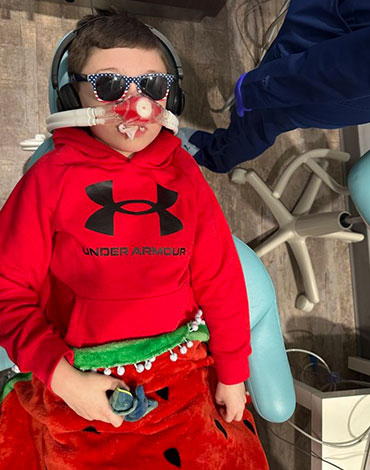We offer several different sedation options to ensure you child has a comfortable dental experience. Conscious sedation is used for our patients who are anxious, have a hard time sitting still for long periods, or require extensive dental treatment.
What is conscious sedation?
Consious sedation dentistry allows your pediatric dentist to provide a variety of dental treatments safely and comfortably for children who experience anxiety when visiting the dentist. Your child will be drowsy, but easily arousable.
How are sedatives administered?
- Oral — An extremely common technique for dental sedation is oral sedation. It is easy and does not require the use of needles. Your child will be given an oral medication that is taken about an hour before the appointment (in our office). Once the medication takes affect (45 minutes to an hour) we will begin treatment. If your child is unable to take medications orally, we can administer the medication intra-muscularly. In addition to the oral medication, we will use nitrous oxide once we start treatment.
- Inhalation — Nitrous oxide, or laughing gas, is the most frequently used method for easing mild to moderate anxiety. Recovery is quick so your child can resume normal activities immediately. We use nitrous oxide in addition to oral medications to help titrate the sedation to achieve the best results. Your child is always receiving oxygen in conjunction with nitrous oxide.
Please contact our practice to schedule a consultation, learn more about sedation dentistry, and find out which sedation dentistry method may be right for your child.
Before your child's oral sedation visit:
- Please notify our office with any changes to your child's medical history.
- Please call us if your child has had a cough, cold, fever, congestion, or respiratory infection four weeks prior to the appointment.
- Patients can NOT eat or drink after midnight the night before their appointment.
- Wear loose-fitting, comfortable clothing the day of treatment; no thick sweaters.
After your childs oral sedation visit:
- Your child will be sleepy following treatment. Please go directly home and rest until your child has fully recovered from the medications.
- While your child may seem alert on discharge, this can be misleading. Continue to monitor your child closely through out the day. Limit activity (no sports, running, jumping etc.) as their balance will be impaired the day of treatment.
- Always hold your child's hand while walking.
- Your child may have liquids or soft foods that do not require chewing (Jell-O, popsicles) once you are home. At this time you can administer Tylenol® or Motrin®.
- Once the anesthesia has worn off, your child can have a soft diet, gradually progressing to a normal diet through out the day. Fluid intake is more important than intake of solid foods.
Please contact us with any questions or concerns at (832) 930-7750.

